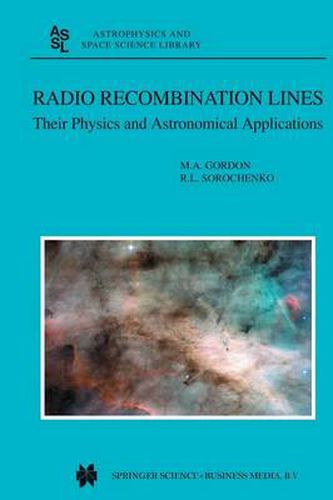Readings Newsletter
Become a Readings Member to make your shopping experience even easier.
Sign in or sign up for free!
You’re not far away from qualifying for FREE standard shipping within Australia
You’ve qualified for FREE standard shipping within Australia
The cart is loading…






This title is printed to order. This book may have been self-published. If so, we cannot guarantee the quality of the content. In the main most books will have gone through the editing process however some may not. We therefore suggest that you be aware of this before ordering this book. If in doubt check either the author or publisher’s details as we are unable to accept any returns unless they are faulty. Please contact us if you have any questions.
Recombination lines at radio wavelengths have been - and still are - a pow erful tool for modern astronomy. For more than thirty years they have allowed astronomers to probe the gases from which stars form. They have even been detected in the Sun. In addition, observations of these spectral lines facilitate basic research into the atom, in forms and environments that can only exist in the huge dimensions and extreme conditions of cosmic laboratories. We intend this book to serve as a tourist’s guide to the world of Radio Recombination Lines. It contains three divisions: a history of their discovery, the physics of how they form and how their voyage to us influences their spectral profiles, and a description of their many astronomical contributions to date. The appendix includes supplementary calculations that may be useful to some astronomers. This material also includes tables of line frequencies from 12 MHz to 30THz (AlOJLm) as well as FORTRAN computer code to calculate the fine structure components of the lines, to evaluate radial matrix integrals, and to calculate the departure coefficients of hydrogen in a cosmic environment. It also describes how to convert observational to astrophysical units. The text includes extensive references to the literature to assist readers who want more details.
$9.00 standard shipping within Australia
FREE standard shipping within Australia for orders over $100.00
Express & International shipping calculated at checkout
This title is printed to order. This book may have been self-published. If so, we cannot guarantee the quality of the content. In the main most books will have gone through the editing process however some may not. We therefore suggest that you be aware of this before ordering this book. If in doubt check either the author or publisher’s details as we are unable to accept any returns unless they are faulty. Please contact us if you have any questions.
Recombination lines at radio wavelengths have been - and still are - a pow erful tool for modern astronomy. For more than thirty years they have allowed astronomers to probe the gases from which stars form. They have even been detected in the Sun. In addition, observations of these spectral lines facilitate basic research into the atom, in forms and environments that can only exist in the huge dimensions and extreme conditions of cosmic laboratories. We intend this book to serve as a tourist’s guide to the world of Radio Recombination Lines. It contains three divisions: a history of their discovery, the physics of how they form and how their voyage to us influences their spectral profiles, and a description of their many astronomical contributions to date. The appendix includes supplementary calculations that may be useful to some astronomers. This material also includes tables of line frequencies from 12 MHz to 30THz (AlOJLm) as well as FORTRAN computer code to calculate the fine structure components of the lines, to evaluate radial matrix integrals, and to calculate the departure coefficients of hydrogen in a cosmic environment. It also describes how to convert observational to astrophysical units. The text includes extensive references to the literature to assist readers who want more details.